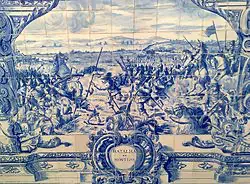King Philip IV of Spain
Part 2: Fighting the Tide
French forces decisively defeated the Spanish force at the Battle of Rocroi in 1643, but the war dragged on. Negotiators from all countries involved had been meeting for some time to discuss terms of a truce. Bavaria, Cologne, France, and Sweden signed such an agreement, the Truce of Ulm, in 1647. Spain, despite sending troops home to crush a revolt in Catalan and uprising in Portugal, soldiered on, with Philip IV unwilling to admit defeat until all other options (not to mention his royal forces) were exhausted. In 1648, a French force under Louis II de Bourbon, Prince de Condé defeated the Spanish at the Battle of Lens. In that same year, the culmination of four years of negotiations was the Peace of Westphalia, which technically ended the wide war between Catholics and Protestants. The twin treaties that made up the Peace did not, however, bring peace in the case of France versus Spain. Those two countries continued to fight each other. France carried on the war effort, winning a significant victory at Arras and then flooding Flanders with French troops, sending the Spanish reeling. On the other side, Spain claimed victories at Pavia and in Lombardy. France, with no plentiful navy to call its own, hammered out an alliance with England in 1657, and English troops and ships were fighting on the side of the French (a not all that common occurrence). France and Spain also battled for control of Northern Italy, with Spain winning a significant victory in Lombardy in the waning stages of the war and turning back a determined attempt by French allies Modena and Savoy to seize control of Spanish-controlled Milan (which had been in French hands two centuries before). A joint English-French attack in 1658 took control of the port city of Dunkirk, and Spain asked for peace. France initially refused but, seeing the possible end of the alliance with England because of political upheaval there, eventually agreed. The two major powers began negotiating on May May 8, 1659, and signed the Peace of the Pyrenees on November 5 of that same year. France gained some territory as a result of the peace agreement. Artois and Hainaut moved from the Spanish Netherlands into the boundaries of France, as did Roussilon, otherwise known as northern Catalonia. To seal the deal, the French king, Louis XIV married Maria Theresa, the daughter of King Philip IV. 
In a way that his father and grandfather hadn't, Philip had time for the arts. He was a patron of Diego Velásquez, one of Spain's most famous painters (who validated that support by creating several paintings of the king), and of the Spanish authors Francisco de Quevedo and Lope de Vega. The king also collected paintings from other European artists. The king enjoyed the arts and entertainment and, in 1631, ordered built the Buen Retiro palace, a large structure that housed a ballroom, theater, galleries to display his large art collection, and even a bull ring. Such ostentatious displays of opulence did little to endear the king to most of his subjects. As had his father, Philip IV struggled with finances throughout his reign. The cost of maintaining a far-flung empire and of fighting wars against a handful of determined foes resulted in the government's declaring bankruptcy in 1647 and in 1653. Haro, as the king's chief minister, had struggled along, trying to keep the ship afloat. He died in 1661, and Philip named as his replacement the Duke of Medina de las Torres, who was the son-in-law of Olivares. Philip's wife, Isabella, had died in 1644 after giving birth to seven children. The king had hoped for a son to succeed him; only of one those seven children was a son, Balthasar, and he had died in 1646. Philip married again in 1649, to Maria Anna, whose father was the Holy Roman Emperor Ferdinand III. Philip and Maria Anna had five children together; only two of those children surived into adulthood. Their eldest child, Margarita Teresa, eventually married the Holy Roman Emperor Leopold I. Their sole son, Charles, was born in 1661. Philip IV died in 1665; he was 60. His son succeeded him as King Charles II. First page > Inheriting a War > Page 1, 2 |
|
Social Studies for Kids
copyright 2002–2024
David White



 In 1640, Portugal revolted against Spanish rule, forcing Philip to concentrate some of his forces on the home front. At the same time, Philip had a final falling out with Olivares and dismissed him. The king initially proclaimed that he would be his own First Minister but later named to the position Olivares's nephew, Luis de Haro, who had been a childhood playmate of the king.
In 1640, Portugal revolted against Spanish rule, forcing Philip to concentrate some of his forces on the home front. At the same time, Philip had a final falling out with Olivares and dismissed him. The king initially proclaimed that he would be his own First Minister but later named to the position Olivares's nephew, Luis de Haro, who had been a childhood playmate of the king.
